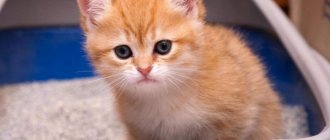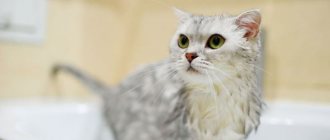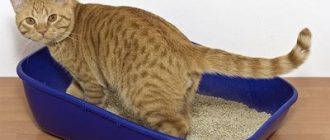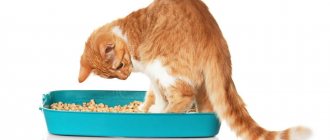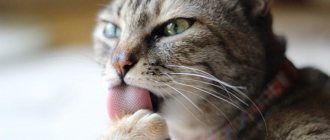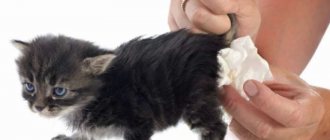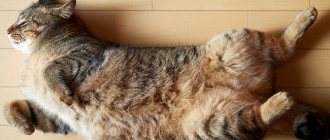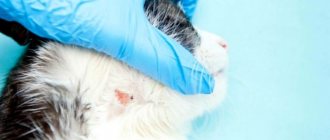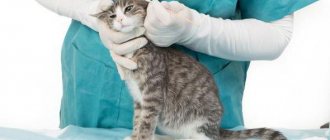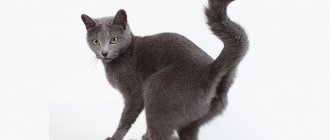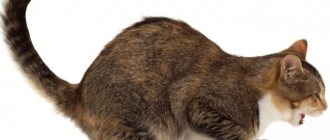- What can cause vomiting and diarrhea in cats?
- Vomiting and diarrhea in a cat what to do in case of emergency
- Diarrhea and vomiting in cats: treatment and prevention
Cats are very sensitive animals and therefore their body can react to various irritants by vomiting and/or diarrhea.
Isolated cases should not cause any particular concern to owners; it is enough to just identify the source of the trouble. It’s another matter if there is constant diarrhea and vomiting in a cat, the reasons for which may be simply banal or, on the contrary, become a herald of the development of dangerous diseases or intoxication of the body.
What to do if your cat has diarrhea and vomiting
For short-term attacks, serious treatment is usually not required. For example, if the cause is sun or heatstroke, the cat is placed in a cool room. If a pet has swallowed fur, as soon as it comes out, the condition returns to normal. It’s worse if nausea and diarrhea last more than a day. This causes dehydration and can lead to death.
You are allowed to provide assistance on your own, but your pet urgently needs to be shown to a veterinarian. Only he will be able to establish the cause of the ailment and select the correct treatment.
Reasons for violation
If the cat returned to normal within 24 hours, the diarrhea and nausea disappeared, then most likely the cause was simple poisoning. No need to worry about this. However, to prevent this from happening in the future, you should :
- exclude low-quality or expired products from your pet’s diet;
- try changing your diet;
- set a clear time for feeding the cat, try to prevent the animal from overeating and swallowing large pieces of food;
- Include vegetable oil in your cat’s diet to improve wool digestion.
If a cat vomits and diarrhea for more than a day, then the reasons for this may be::
- allergic reactions to food or medications;
- damage to the body by infections;
- helminths in internal organs;
- formations in the gastrointestinal tract;
- adverse reactions to medications taken;
- heat or sunstroke;
- liver and kidney diseases;
- reaction to a certain type of food.
The reasons for vomiting blood in a cat lie in the presence of helminths in the animal. They penetrate the internal organs and slowly destroy them. Hence the appearance of blood particles in the vomit.
© shutterstock
Treatment and first aid
With severe nausea and diarrhea, dehydration occurs. The cat becomes weak and cannot always reach the bowl. Therefore, the second one is placed next to the bed. It is recommended to pour only boiled or bottled liquid.
If the cat does not drink, they force him to drink - after each bowel movement or attack. Water is poured into the mouth from a syringe (without a needle). Feeding stops immediately. This reduces the load on the gastrointestinal tract. Symptoms may be caused by intoxication of the body. Smecta, Enterosgel, and activated carbon help improve the condition . These drugs can be given before consulting a doctor.
The first two medications are fed ½ sachet immediately after vomiting, after each bowel movement. If the animal refuses to lick the gel, it is diluted with a small amount of liquid. If coal is given, 2-3 tablets are crushed to a powder. Dilute in 2 tbsp. l. water, pour in with a syringe.
Treatment depends on the cause of the vomiting and diarrhea. If it is physiological (stress, rapid swallowing of food, foreign body entering the stomach), then the attacks will go away on their own. In some cases, more serious measures may be needed. If your cat has diarrhea and vomiting, how to treat it depends on the following:
- worms - give anthelmintic drugs;
- infection through dirty dishes, raw food - the pet’s bowl is thoroughly washed;
- diseases – eliminate the original pathology;
- disruption of the gastrointestinal tract - give crushed “Pancreatin” ;
- a consequence of taking antibiotics - Hilak Forte .
It is important to provide the animal with rest. Eliminate irritating factors (attention from other pets, noise), stress. It’s hard for the cat at this time, she becomes irritable. Therefore, it is important to be patient, talk, act carefully, affectionately. She will feel supported and will tolerate treatment more easily.
What to give a kitten for vomiting and diarrhea as first aid
Small kittens have fragile bodies. Adult medications are not recommended for them. The exceptions are “Phosphalugel”, “Enterosgel”, “Smecta”, “Hilak Forte” . After each attack, the kitten is given 1 tsp. gel.
If he refuses to lick it, the product is diluted with water, then infused forcibly. At the same time, the kitten is put on a starvation diet for 12 hours. Make sure a bowl of water is available. However, this does not cancel an urgent trip to a specialist.
First aid for adult cats
When nausea or diarrhea occurs, sorbents are given - Smecta, Phosphalugel . If they do not help, a doctor's examination is required. At the same time, they are put on a starvation diet for at least a day. If the cat does not drink on its own, they do it by force. However, the risk of another attack increases.
If it is not possible to see a doctor immediately, Ringer-Locke . Usually IVs are given. But without experience it is difficult and dangerous to do this, then you can administer the drug subcutaneously. For an average-sized animal, 150 ml per day is required. However, in any case, the cat must be taken to the veterinary clinic.
Prevention
To prevent nausea and diarrhea, the following measures should be taken:
- Carry out parasite treatment according to schedule. The drugs are given to animals at least every six months. If your pet eats meat or goes outside, the procedure should be carried out once every 3 months.
- Switch your cat to natural food or buy high-quality food. The diet should be balanced. Super-premium or holistic products are suitable for continuous feeding.
- Do not mix several types of food. A cat's stomach quickly gets used to digesting one type of food. Combining different types of food (especially in one feeding) or adding supplements will cause digestive upset.
- Maintain good hygiene. Bowls must be clean. When eating natural food, leftovers must be removed immediately to prevent poisoning and bacterial growth.
- Do not suddenly switch your cat to another diet. The transition should be carried out gradually, over 10-14 days.
- Minimize interaction with other animals. Outdoor cats can cause your pet to become infected.
If your cat sometimes burps in the morning or after eating, you should contact your veterinarian promptly. This may be a sign of the initial stage of the disease. Even in the absence of a pathological cause, irritation of the gastrointestinal tract can provoke the occurrence of disorders.
All information posted on the site is provided in accordance with the User Agreement and is not a direct instruction to action. We strongly recommend that before using any product, you must obtain a face-to-face consultation at an accredited veterinary clinic.
What to feed a sick cat with diarrhea and vomiting
In case of diarrhea and nausea, the animal is put on hunger, but it cannot be kept without food for a long time. As soon as the condition improves, the cat is gradually fed. On the first day, give a third of the daily portion. The canned food is slightly diluted with water, and the granules are soaked to a paste.
| Can | It is forbidden |
| Rice is included in the diet. After a couple of days, you can supplement it with fermented milk products and foods containing fiber. Boil a small piece of meat and feed it chopped. Food should be soft, quickly digested, without burdening the stomach or causing irritation. | Chicken, dairy products, solid and rough foods are prohibited. In the first two days, any canned food, dry food, or fatty foods are excluded. |
Feed in small portions every 2-3 hours. They stay on this diet for a week, then switch to their previous diet.
If a cat experiences short-term vomiting or diarrhea (up to a day), it is often enough to give sorbents. They will remove toxins from the body. If attacks last more than a day or become more frequent, it is necessary to urgently take the animal to a specialist.
How can I help you?
In severe cases, dehydration occurs quickly. It is indicated by:
- the fold of skin on the withers, if you pull it back, straightens out in more than 2 seconds;
- no shine in the whites of the eyes;
- the nose and mucous membranes of the mouth are dry.
The doctor will prescribe: injections or drips to relieve intoxication and administer nutrients; diet, procedures and medications, and sometimes operations.
Home help will also be required from the owner using the methods that he knows (some of them are listed above*), but strictly in agreement with the doctor!
For example, Phthalazol tablets (for humans) are suitable for diarrhea:
- Crush ¼ tablets into dust, shake until suspended in 2-5 ml of warm boiled water (measure with a syringe);
- immobilize the cat by wrapping it in a towel, inject a few drops into the side of the mouth with a syringe and stroke and soothe it while it swallows this tasty medicine; and so on until it ends.
Only 2 doses of Phthalazol (morning and evening) will help.
For infrequent vomiting, use 1 tbsp 3 times a day. l. any of these remedies: a decoction of rice, chamomile, flax seeds or oak bark; St. John's wort infusion.
Symptoms of diarrhea in a cat
If a cat has eaten something stale or unusual, then diarrhea may be accompanied by frequent bowel movements, flatulence, and bloating. In the case of a disease, the number of symptoms can increase to a dozen.
Signs of pathological stool disorder
In addition to soft feces, loose stools in a cat are accompanied by the following symptoms:
:
- apathetic behavior;
- vomit;
- lack of appetite;
- weight loss due to long-term disorder;
- dangerous dehydration;
- impurities of blood, mucus, undigested pieces of food;
- temperature increase;
- hard belly
Properly selected treatment will help get rid of the pathology without a trace. However, a veterinarian will be able to formulate a complete picture of the disease after receiving information about the patient’s behavior over the past few days. During the examination, the specialist will check your body temperature, feel the abdominal area, and determine the degree of dehydration. Analyzes of discharge for the presence of parasites or impurities, as well as x-rays, will help diagnose the cause of the disease with the greatest accuracy.
Duration of diarrhea in a cat
The appearance and disappearance of symptoms of pathology can go unnoticed by the owner. In an isolated case of diarrhea in a cat, there is nothing to worry about, but prolonged distress becomes an alarming sign. Doctors talk about three forms of pathology:
- Acute type, which is accompanied by painful, frequent bowel movements. The malaise lasts for several days.
- Chronic form, lasting more than 7 days and causing severe exhaustion with dehydration.
- The intermittent type is periodic in nature. It sometimes returns within 1 month.
Diarrhea in a cat, which appears due to an incorrectly selected menu, goes away quickly after changing the diet. The functioning of the gastrointestinal tract is restored, and stool returns to normal. Therapeutic nutrition involves a diet with limited food and plenty of water. Diseases of another type require great attention from the veterinarian and the owner.
Some features of the disorder in kittens
In a kitten, diarrhea may begin suddenly, due to a weak gastrointestinal tract. Children are more susceptible to attacks from viruses and bacteria than adults, and also react more strongly to stale or too fatty foods.
A kitten that has just been weaned from its mother often has bowel movements. To prevent this from happening, it is better to take the kitten from the family where it was gradually transferred to solid food. A sharp separation from mother's milk can provoke a number of diseases - and not only gastrointestinal ones.
In some cases, loose stool in a kitten signals serious diseases for which it was not vaccinated yet - panleukopenia (distemper) or leptospirosis. Here, the chances of survival depend on the speed of treatment and the baby’s immune system.
Only a veterinarian can tell you how to treat diarrhea in a kitten, since any prescription of drugs must be strictly adjusted in dose and duration of use. The main task of the owner before prescribing therapy is to replenish the lack of fluid in the baby’s body.
Digestive problems in a pregnant or lactating female
The expectant mother is more susceptible to attacks from viruses or bacteria than other individuals. Any pathogenic microorganisms that enter the body of a pregnant female cause problems in the gastrointestinal tract. New foods can also cause intolerance and intestinal reactions. Such products include beef, horse meat, soybeans, fatty fish, chicken eggs, and high-calorie dairy products.
Often, even habitual food causes frequent bowel movements in a pregnant female. You should not feed an eternally hungry expectant mother with food from the master's table. Excessive amounts of food do not have time to be digested, leaving in the form of liquid feces. This pathology can provoke a miscarriage. However, the appearance of diarrhea a couple of days before giving birth is considered normal.
The factor that provokes diarrhea in a nursing female is most often milk. Its excessive consumption in its natural form is not very beneficial for the pet. Milk should be replaced with cottage cheese, fermented baked milk, kefir or unsweetened yogurt.
Another reason for weakened intestines can be hormonal changes in the body or postpartum stress. Due to feeding, the water-salt balance is disrupted.
